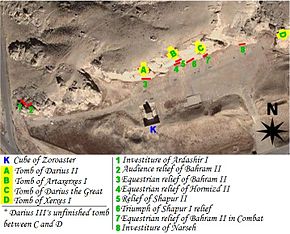Naqsh-e Rustam
| نقش رستم | |

Map of the archaeological site of Naqsh-e Rustam
|
|
| Location | Fars Province, Iran |
|---|---|
| Coordinates | 29°59′20″N 52°52′29″E / 29.98889°N 52.87472°ECoordinates: 29°59′20″N 52°52′29″E / 29.98889°N 52.87472°E |
| Type | Necropolis |
| History | |
| Periods | Ahaemenid, Sassanid |
| Cultures | Persian |
Naqsh-e Rustam (Persian: نقش رستم [ˌnæɣʃeɾosˈtʰæm]) is an ancient necropolis located about 12 km northwest of Persepolis, in Fars Province, Iran, with a group of ancient Iranian rock reliefs cut into the cliff, from both the Achaemenid and Sassanid periods. It lies a few hundred meters from Naqsh-e Rajab, with a further group of Sassanid reliefs.
The oldest relief at Naqsh-e Rustam dates back to c. 1000 BC. Though it is severely damaged, it depicts a faint image of a man with unusual head-gear, and is thought to be Elamite in origin. The depiction is part of a larger mural, most of which was removed at the command of Bahram II. The man with the unusual cap gives the site its name, Naqsh-e Rustam ("Rustam Relief" or "Relief of Rustam"), because the relief was locally believed to be a depiction of the mythical hero Rustam.
Four tombs belonging to Achaemenid kings are carved out of the rock face at a considerable height above the ground. The tombs are sometimes known as the Persian crosses, after the shape of the facades of the tombs. The entrance to each tomb is at the center of each cross, which opens onto to a small chamber, where the king lay in a sarcophagus. The horizontal beam of each of the tomb's facades is believed to be a replica of a Persepolitan entrance.
One of the tombs is explicitly identified, by an accompanying inscription, as the tomb of Darius I (c. 522-486 BC). The other three tombs are believed to be those of Xerxes I (c. 486-465 BC), Artaxerxes I (c. 465-424 BC), and Darius II (c. 423-404 BC) respectively. The order of the tombs in Naqsh-e Rustam follows (left to right): Darius II, Artaxerxes I, Darius I, Xerxes I.
...
Wikipedia

